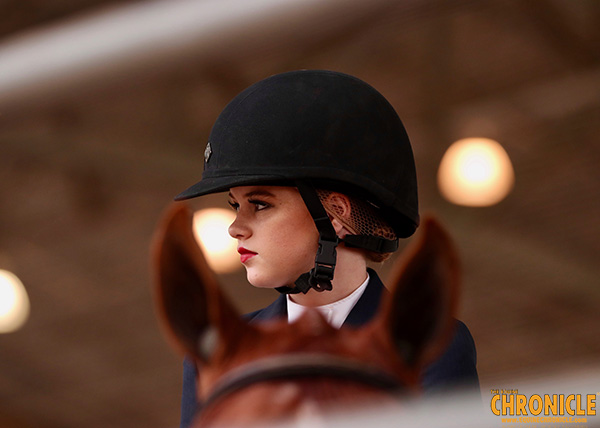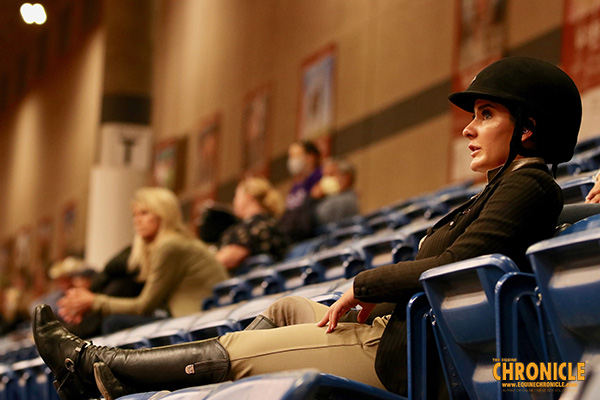Use Fear-Setting to Conquer Your Next Horse Show

“Inaction breeds doubt and fear. Action breeds confidence and courage. If you want to conquer fear, do not sit home and think about it. Go out and get busy.”
– Dale Carnegie
By: Brittany Bevis
What are you afraid of? The answer is different for everyone. There are plenty of fearful situations that can arise when riding and showing horses. For example, a beginner rider might be afraid of attempting a new skill, while a more experienced rider might be afraid of not delivering a top performance when it counts.
Almost every rider will admit to, at some point, being afraid of disappointing their trainer or family; being afraid of losing; or being afraid of making a mistake.
After an injury, a rider might be afraid of getting back in the saddle. In this type of situation, there might even be fear of the horse, itself. A horse show parent might have a fear of financial insecurity. There is the fear of failure, the fear of ridicule, the fear of disappointment, the fear of injury, ect.
Fear can be paralyzing, causing in-action, anxiety, and reduced performance. But what can you do about it? There is a three-step system that will help you face your fear, take away its power, and make a plan of action.
It’s called Fear-Setting.
Fear-Setting is a technique made popular by American author, entrepreneur, and public speaker, Tim Ferris. The thought process behind fear-setting is that instead of obsessing about your fears, it’s more productive to face them head on. But how do you do that, exactly? By putting them under a microscope.
 The three-pronged approach includes these key steps:
The three-pronged approach includes these key steps:
- Define
- Prevent
- Repair
Divide a sheet of paper into three sections with the subtitles listed.
Define
What’s the worst thing that could happen? In this section, you should define your fear. List your worries and concerns. Writing down your fears or saying them out loud helps to take away their power.
Fear is an uncomfortable emotion. As a self-protection mechanism, the brain often exaggerates our fears making them seem worse than they actually are. By defining your fear and examining it in a logical manner, you can gain some clarity about why you’re fearful in the first place.
For example, an equestrian named Sally has a fear that she will mess up her flying lead change in her Horsemanship pattern. In this section, Sally should write down her specific fear or worry.
Example- I’m afraid that I will mess up my flying lead change and ruin my pattern and chance of placing.
Prevent
How do I prevent this from happening? Think about the steps you can take that will stop the uncomfortable experience from taking place.
In Sally’s case, she should think about skills and techniques she may have learned that are crucial to performing a flying lead change with success.
Example- Make sure to push my horse’s hip over before asking for the change. Keep my horse’s body in proper alignment. Remember to use my feet and count strides to ask at the right time.
Repair
If the worst does happen, how can I fix it? If your fear is realized, what happens now? What will you do? This is where you make a plan for how you can fix the damage. Write down a list of actions you can take to get yourself back on track.
If Sally performs a less than stellar lead change, what should she do?
Example- Let go of what happened. Refocus and look ahead to the next maneuver. Make sure the rest of the pattern is flawless.
This is where the original exercise ends, but we would like to propose a fourth section- Respond.
Respond
How will you respond? Sometimes, bad things happen, but it’s how you choose to respond that makes all the difference. In the case that you weren’t able to prevent the uncomfortable situation from happening, and you’ve tried to repair some of the damage, what happens now? Where do you go from here? In this section, list positive emotional responses to the situation and how you plan to accomplish moving on in the face of adversity.
In Sally’s situation, she should think about the emotions she’s feeling and how she will choose to respond to the situation.
Example- I’m frustrated that my lead change didn’t go the way I’d hoped, but I was pleased with my spins and transitions. I will work harder on my lead change outside of the show pen and come back ready to crush the next pattern.
The next time you’re feeling overwhelmed or fearful, whether it’s ahead of a big competition, or just in everyday life, try out this strategy.
Enjoyed this article? Would you like more mental strength tips for equestrians? Email B.Bevis@EquineChronicle.com with your topic suggestions.










